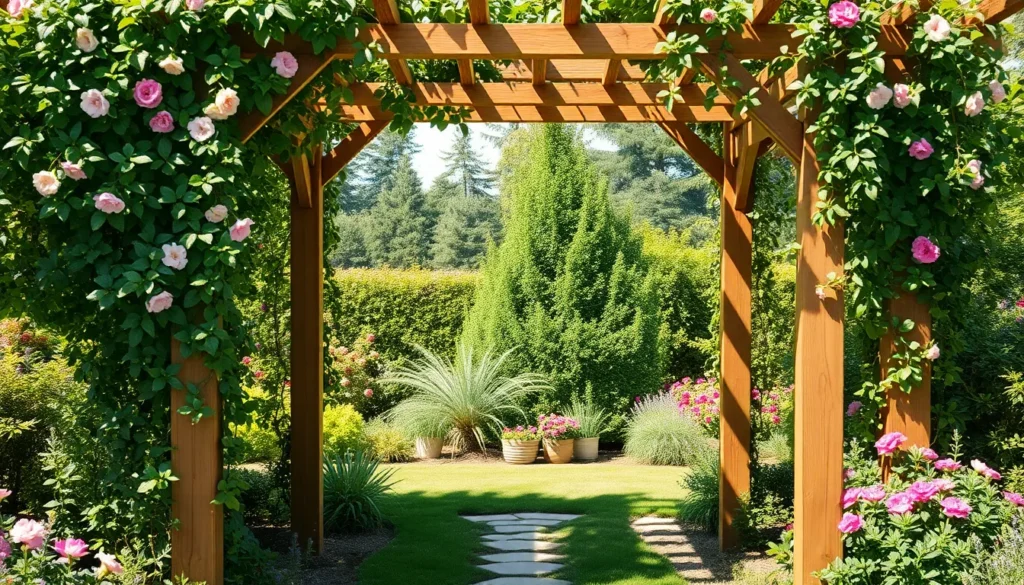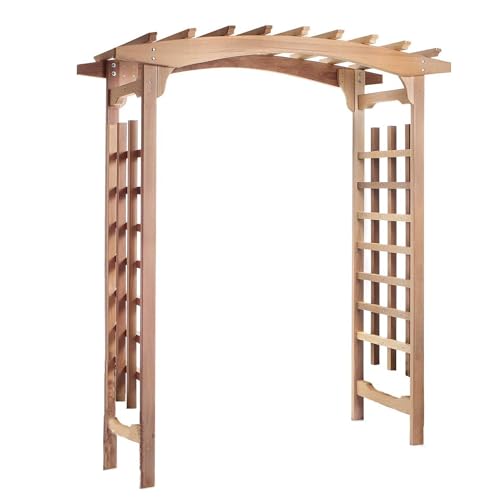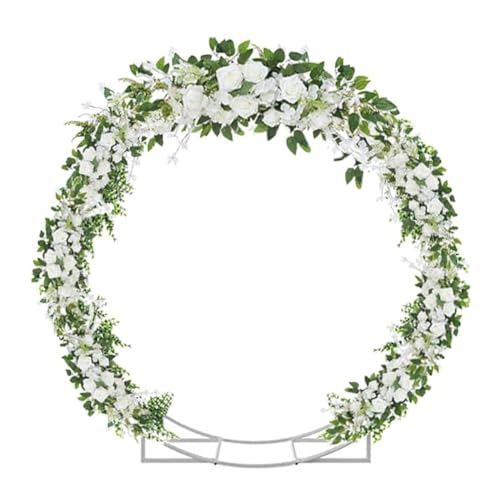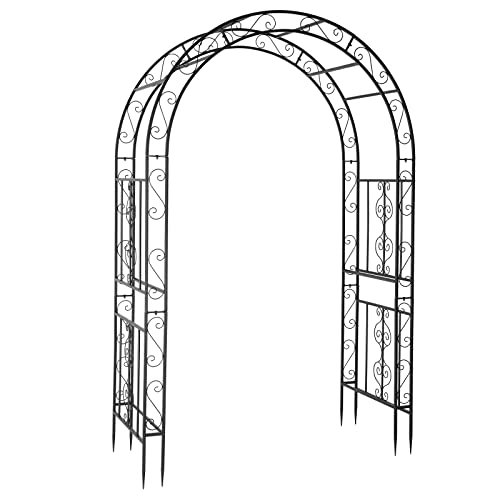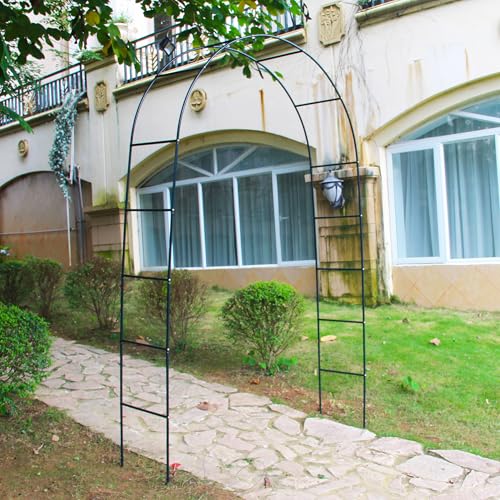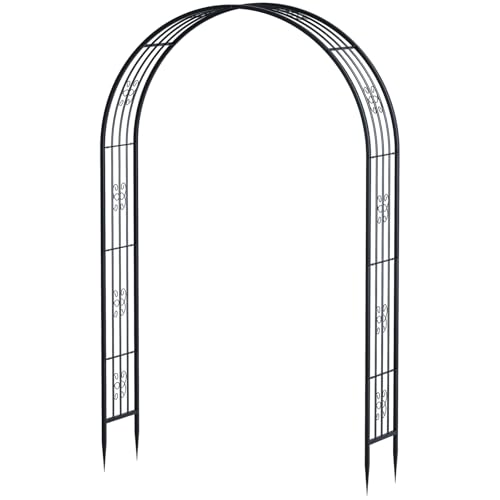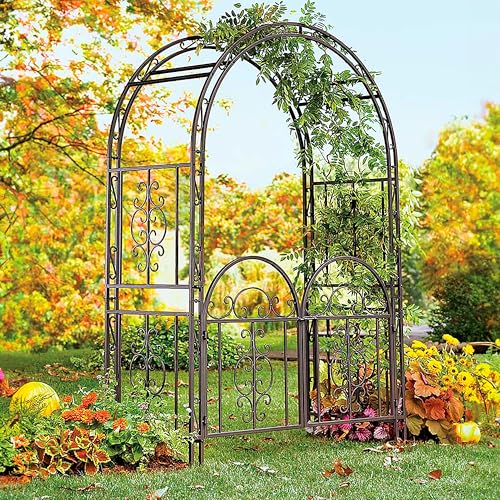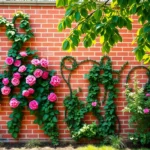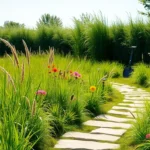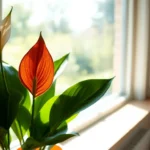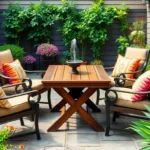We’ve all dreamed of that perfect garden entrance that makes guests stop and admire before they even step inside. A well-designed garden arbor transforms any ordinary pathway into a stunning focal point that defines your outdoor space with elegance and charm.
Garden arbors aren’t just beautiful structures – they’re functional design elements that create natural divisions between different areas of your industry. Whether you’re looking to frame a garden gate, support climbing vines, or simply add vertical interest to a flat yard, the right arbor can completely elevate your garden’s aesthetic appeal.
From rustic wooden designs that blend seamlessly with cottage gardens to sleek metal structures that complement modern landscapes, we’ll explore dozens of creative arbor ideas that suit every style and budget. You’ll discover how these versatile structures can solve common garden challenges while adding that wow factor you’ve been searching for.
Classic Wooden Arbors for Timeless Garden Appeal
Wooden arbors remain the gold standard for garden entrances that never go out of style. These versatile structures blend seamlessly with any industry design while providing the perfect framework for climbing plants and flowers.
Traditional Cedar Arch Designs
Cedar arbors offer natural weather resistance that makes them ideal for long-term garden installations. We recommend cedar for its ability to withstand moisture, insects, and temperature fluctuations without requiring frequent maintenance treatments.
Curved arch styles create a romantic entrance that draws visitors deeper into your garden space. These designs typically feature smooth, flowing lines that complement both formal and cottage garden settings.
Gothic pointed arches add dramatic height and architectural interest to garden pathways. The upward-pointing design creates visual lift while providing ample clearance for climbing roses or clematis vines.
Simple rectangular frames work perfectly for minimalist garden designs where clean lines take priority. These structures often incorporate lattice side panels that support lightweight climbing plants like morning glories or sweet peas.
Rustic Log and Branch Constructions
Natural log arbors bring an organic, woodland aesthetic to garden spaces. We’ve found that using locally sourced materials creates authentic rustic charm while supporting sustainable gardening practices.
Split rail designs use horizontal logs between vertical posts for a classic frontier appearance. These sturdy constructions can support heavy climbing plants like grape vines or hardy kiwi.
Branch and twig accents add textural interest to basic log frameworks. Weaving smaller branches between main support beams creates natural patterns that change with the seasons.
Bark-on construction preserves the natural character of wood while providing weather protection. This approach works especially well with birch, oak, or maple logs that develop attractive aging patterns over time.
Painted White Picket Style Arbors
White painted arbors create crisp, clean focal points that brighten garden entrances year-round. We recommend high-quality exterior paint that resists fading and peeling in outdoor conditions.
Traditional picket fence integration extends your existing fence line upward to create a natural garden gateway. This design approach maintains visual continuity while adding vertical growing space for climbing plants.
Lattice top combinations merge solid picket bases with open lattice crowns for varied plant support options. The contrast between solid and open sections creates visual interest while accommodating different climbing plant growth patterns.
Decorative cutout details transform simple white arbors into custom garden features. Heart shapes, diamond patterns, or geometric designs can reflect your personal style while maintaining the classic appeal of painted wood construction.
Metal Garden Arbors for Modern Sophistication
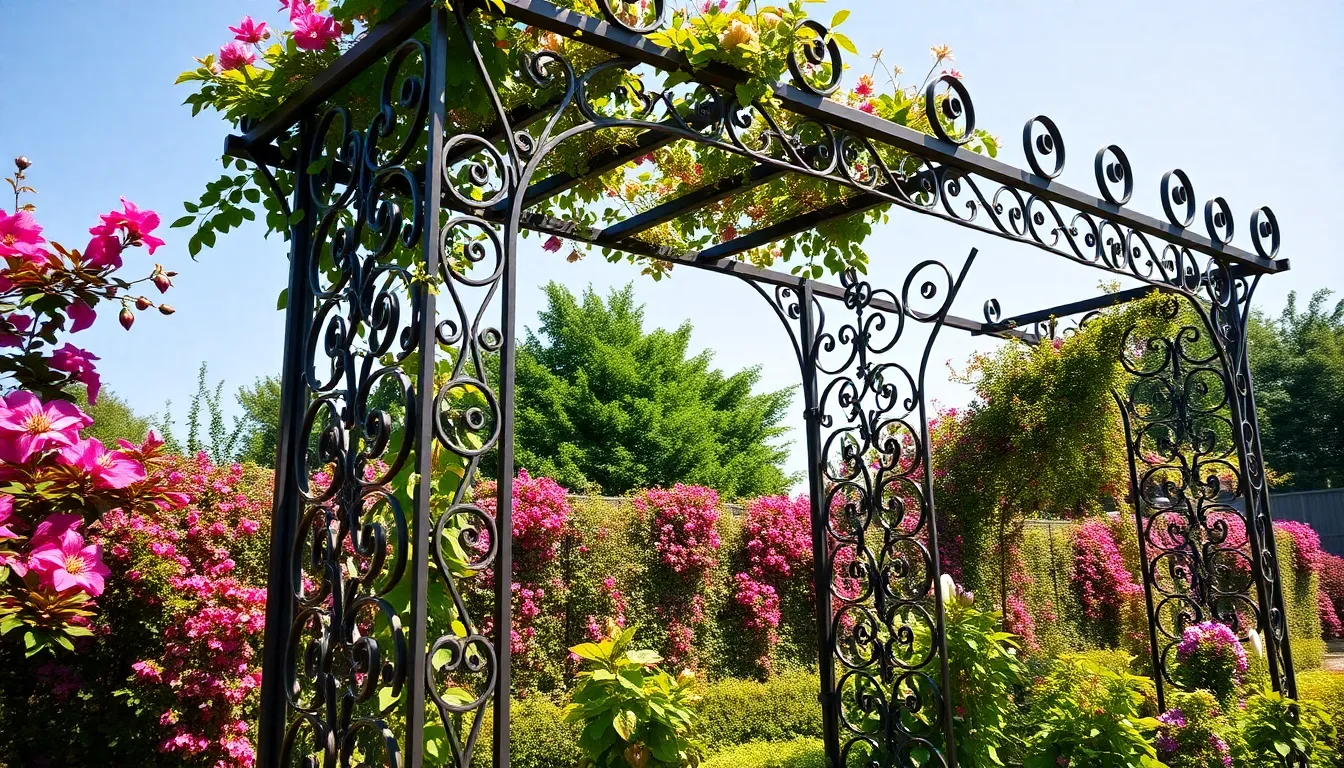
Metal structures bring architectural elegance to outdoor spaces with their clean lines and contemporary appeal. These durable options complement modern landscaping while offering lasting beauty.
Wrought Iron Decorative Archways
Wrought iron arbors stand as the pinnacle of garden sophistication with their intricate metalwork and timeless designs. Elegant floral patterns flow across curved frames, creating stunning focal points that anchor any garden entrance. Classic scrollwork and decorative flourishes add artistic detail without overwhelming the surrounding industry.
Durability makes wrought iron an investment piece that withstands decades of weather exposure. Traditional black finishes provide versatility, while custom powder coating allows personalization with colors that match your home’s exterior. Ornate details like twisted balusters and decorative rosettes elevate these structures beyond simple plant supports.
Installation requires sturdy concrete footings to support the substantial weight. Professional welding ensures joints remain secure through seasonal temperature changes and strong winds.
Contemporary Steel Frame Designs
Steel frame arbors deliver modern minimalism with sleek geometric profiles and unadorned surfaces. Clean horizontal and vertical lines create striking silhouettes that complement contemporary architecture and hardscaping. Powder coated finishes in charcoal, bronze, or custom colors integrate seamlessly with modern outdoor furniture.
Structural strength allows for wider spans without center supports, creating impressive overhead clearance. Square tubing and flat bar construction provide industrial aesthetics while maintaining garden functionality. Modular designs enable custom sizing for exact pathway widths and height requirements.
Climbing plants soften the angular appearance as they mature. Clematis, climbing roses, and jasmine create living walls that frame the metal skeleton beautifully.
Copper and Bronze Accent Pieces
Copper elements introduce warm metallic tones that develop rich patinas over time. Decorative finials, mounting brackets, and joint covers in copper create stunning contrast against darker metal frames. Natural weathering transforms bright copper to deep verde patinas that complement garden foliage.
Bronze hardware adds sophisticated finishing touches through door handles, latches, and decorative medallions. These accent pieces resist corrosion while maintaining their lustrous appearance longer than standard metals. Custom bronze plaques or house numbers can personalize arbor entrances.
Maintenance involves periodic cleaning to control patina development or protective coatings to preserve original copper brightness. Mixed metal designs combining steel frames with copper accents offer the best of both materials’ aesthetic qualities.
DIY Garden Arbor Projects for Budget-Conscious Gardeners
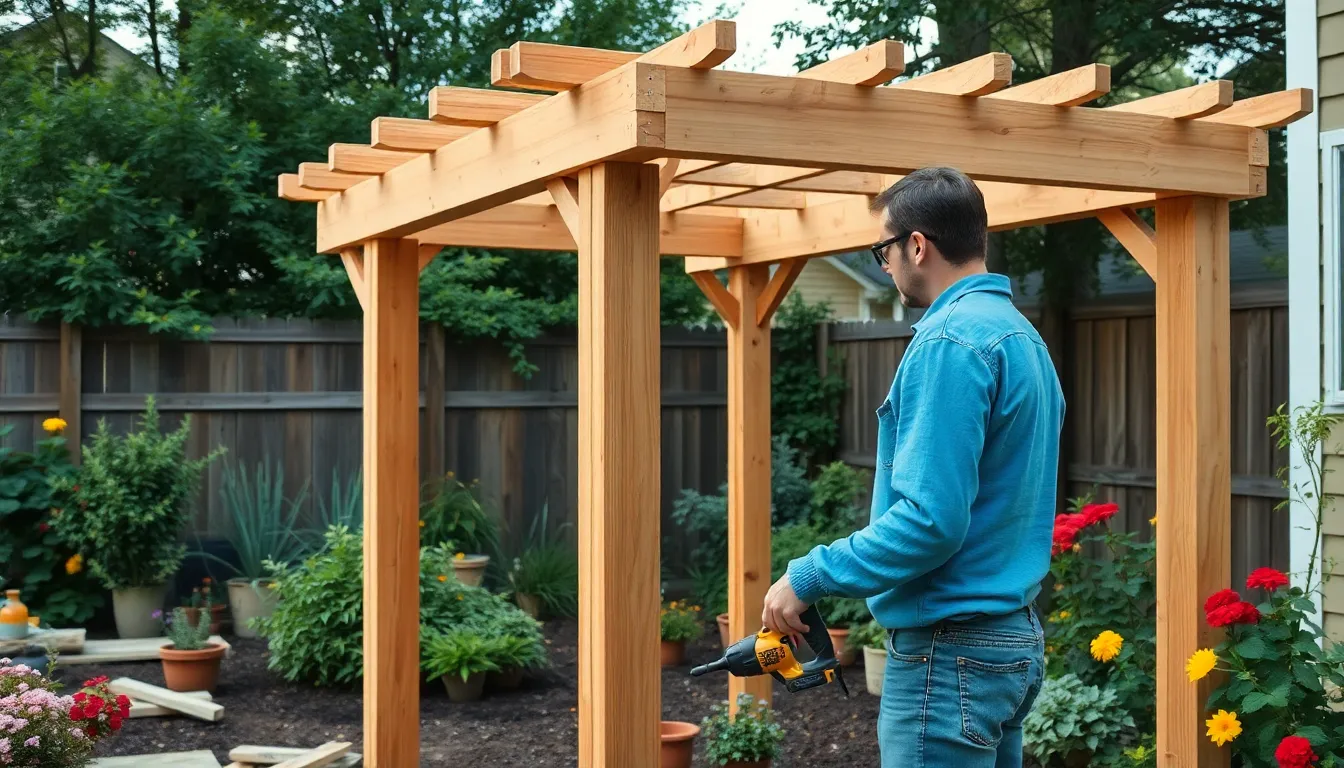
Creating beautiful garden structures doesn’t require very costly when you know the right techniques and materials to use.
Simple Wooden Frame Constructions
Basic wooden arbors offer the most affordable entry point into DIY garden structures. We recommend using 4×4 posts combined with 2×4 lumber to create sturdy frames that can reach heights up to 81.5 inches depending on your post length preferences. Assembly becomes straightforward when you use exterior screws and pocket hole joints to connect the side frames securely.
Standard construction costs remain minimal since these materials are readily available at most hardware stores. Planning your design around common lumber dimensions helps reduce waste and keeps expenses low. Measuring twice and cutting once ensures you won’t need to purchase additional materials due to mistakes.
Cedar wood provides natural weather resistance without requiring expensive treatments, making it an excellent choice for budget builds. Pine lumber costs less upfront but will need regular staining or sealing to maintain its appearance over time. Pressure treated lumber offers a middle ground between cost and durability for most garden applications.
Repurposed Materials and Upcycling Ideas
Old doors transform into unique arbor roofs or decorative side panels with minimal modification required. Salvage yards and demolition sites often have architectural elements available at fraction of retail prices. Vintage doors with glass panels create interesting light patterns when positioned as overhead structures.
Pallet wood delivers rustic charm while keeping material costs near zero for most projects. Construction pallets marked with “HT” stamps indicate heat treatment rather than chemical processing, making them safer for garden use. Disassembling pallets carefully preserves the weathered appearance that adds character to finished arbors.
Metal trellises from discontinued garden center inventory can be incorporated into wooden frames for added durability. Flea markets and estate sales frequently offer ornate metalwork at reasonable prices. Combining metal accents with wooden structures creates visual interest while extending the lifespan of your arbor.
Chicken wire or hardware cloth stretched between posts creates an affordable climbing surface for lightweight vines. Old fence sections can be repurposed as ready made trellis panels with minimal cutting required. Even broken concrete blocks work well as foundation anchors when properly positioned and leveled.
Step-by-Step Building Tutorials
Instructables provides a comprehensive 6 step guide that walks through the entire arbor building process from site selection to final assembly. Site preparation involves checking for underground pipes, tree roots, and large rocks before digging post holes to avoid costly mistakes. Their tutorial emphasizes proper crossbeam attachment techniques that ensure structural stability over time.
Woodshop Diaries offers detailed instructions for building arbors with optional gate features, perfect for creating functional garden entrances. Their approach includes customization options that allow you to adapt the basic design for exact climbing plants like grapes or ornamental vines. Gate integration requires careful hinge placement and proper clearance measurements for smooth operation.
Kreg Tool distributes free DIY arbor plans featuring their pocket hole joinery system for stronger connections. Their step by step instructions include cut lists and hardware recommendations that simplify the building process. Download options provide printable templates that help ensure accurate measurements during construction.
YouTube channels dedicated to woodworking often showcase arbor builds with real time problem solving demonstrations. Local library maker spaces sometimes offer tool lending programs that provide access to specialized equipment without purchase costs. Community college woodworking classes can teach fundamental skills while providing supervised workspace access.
Climbing Plant Combinations for Stunning Arbor Displays
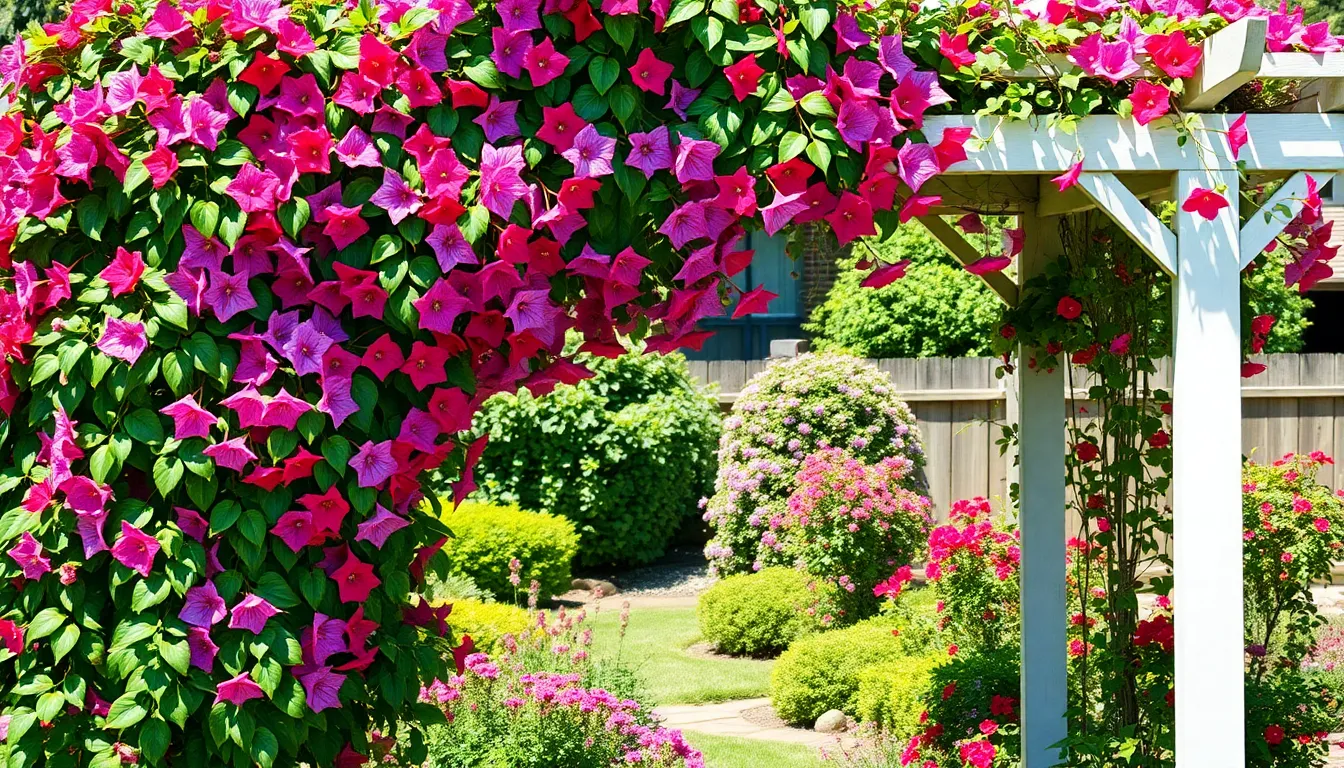
We can transform any garden arbor into a spectacular living structure by carefully selecting and combining climbing plants that complement each other throughout the seasons.
Flowering Vine Selections
Clematis stands out as our top choice for stunning arbor displays with its fast growth rate and self-clinging tendrils that require minimal support. These versatile vines produce large, showy blooms in purple, white, pink, and red throughout the growing season while thriving in full sun to partial shade conditions.
Scarlet runner beans create vibrant displays with their bright red flowers that attract both bees and hummingbirds to our garden spaces. These productive vines offer dual benefits by providing colorful blooms and edible beans while requiring simple trellis support.
Bee balm and lantana combinations deliver extended flowering periods with their diverse color palettes ranging from deep purples to bright yellows. These pollinator magnets ensure our arbors become bustling wildlife habitats while maintaining continuous blooms from spring through fall.
Evergreen Climbing Options
Evergreen clematis varieties provide year-round structure and lush green foliage that serves as a perfect backdrop for seasonal flowering companions. These hardy climbers maintain their leaves throughout winter months while requiring minimal pruning and care.
English ivy creates dense, luxurious coverage that transforms bare arbor structures into living walls of green. This reliable climber adapts to various light conditions and provides consistent coverage while supporting the seasonal plants we layer over it.
These evergreen options ensure our arbors remain attractive focal points even during dormant winter months when deciduous plants lose their leaves.
Seasonal Color Coordination
Spring and summer combinations work best when we pair early blooming clematis with mid-season scarlet runner beans for continuous color transitions. This layered approach ensures our arbors display vibrant blooms from March through September without gaps in flowering periods.
Fall transitions become more dramatic when we incorporate late-blooming asters or sedum varieties that complement the changing foliage colors of deciduous climbing plants. These autumn performers extend our arbor’s visual interest well into October and November.
Winter backbone plants like English ivy or evergreen clematis maintain structure and green color during cold months when most flowering vines enter dormancy. This foundation allows us to plan spring plantings that will emerge from an already established green framework.
Functional Garden Arbor Designs with Built-In Features
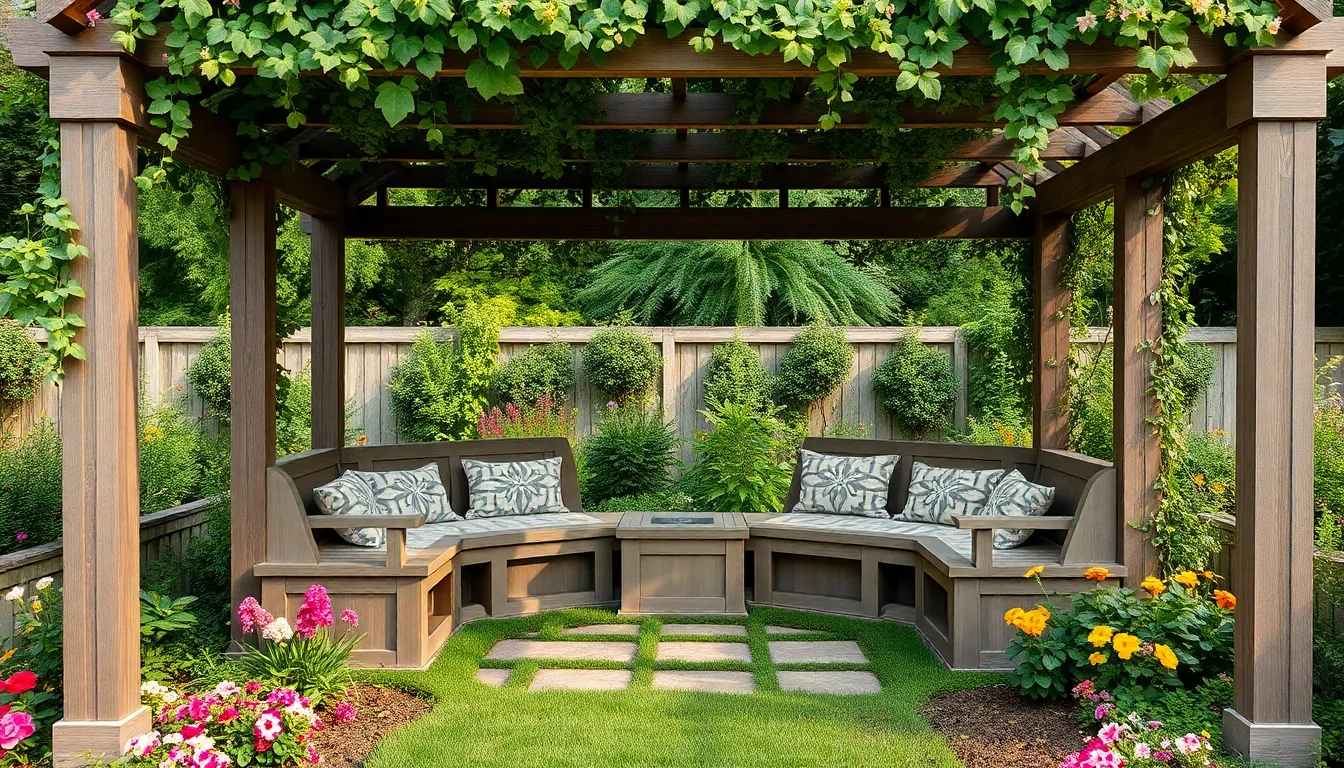
Modern garden arbors can serve multiple purposes beyond their traditional role as plant supports. We’ve compiled innovative designs that maximize functionality while maintaining their aesthetic appeal.
Arbors with Integrated Seating
Bench area integration transforms your arbor into a relaxing retreat where you can enjoy quiet moments surrounded by nature. We recommend positioning built-in benches directly under the arbor’s canopy to create a cozy seating area that’s perfect for morning coffee or evening relaxation.
Seating nooks offer an even more intimate experience by incorporating recessed bench areas into the arbor’s design. These secluded spots provide privacy while you’re surrounded by climbing plants and natural beauty. The integrated seating approach eliminates the need for separate garden furniture and creates a cohesive design element.
Corner bench configurations work particularly well for larger arbors, allowing multiple people to gather comfortably. We suggest adding cushions or weather-resistant padding to enhance comfort during extended use.
Storage Compartment Additions
Hidden storage compartments aren’t standard features in most arbor designs, but they’re becoming increasingly popular among gardeners who want to maximize functionality. We’ve seen innovative designs that incorporate small storage areas for frequently used gardening tools like pruning shears and watering accessories.
Decorative storage answers can be seamlessly integrated into the arbor’s structure without compromising its visual appeal. Consider adding small cubbies or shelving areas that blend with the overall design while providing practical storage space.
Seasonal storage options work well for items like plant stakes, fertilizer, or decorative elements that you’ll use throughout the growing season. We recommend weatherproofing any storage areas to protect your gardening supplies from moisture and temperature fluctuations.
Lighting and Electrical Elements
Solar powered lighting systems offer energy efficient illumination without the complexity of electrical wiring. The PowerGazebo design demonstrates how modern solar technology can be integrated into arbor structures, providing both functionality and contemporary appeal.
String light installations create romantic evening ambiance while highlighting the arbor’s architectural features. We suggest using LED string lights that can withstand outdoor conditions and provide long lasting illumination throughout the seasons.
Integrated electrical systems allow for more sophisticated lighting options, including spotlights that can highlight climbing plants or pathway lighting for safety. Consider consulting with an electrician to ensure proper installation and weatherproofing of any electrical components.
Timer controlled lighting adds convenience by automatically illuminating your arbor during evening hours. We recommend programmable systems that can adjust to seasonal daylight changes, ensuring your garden remains welcoming after dark.
Miniature Arbor Ideas for Small Spaces and Container Gardens
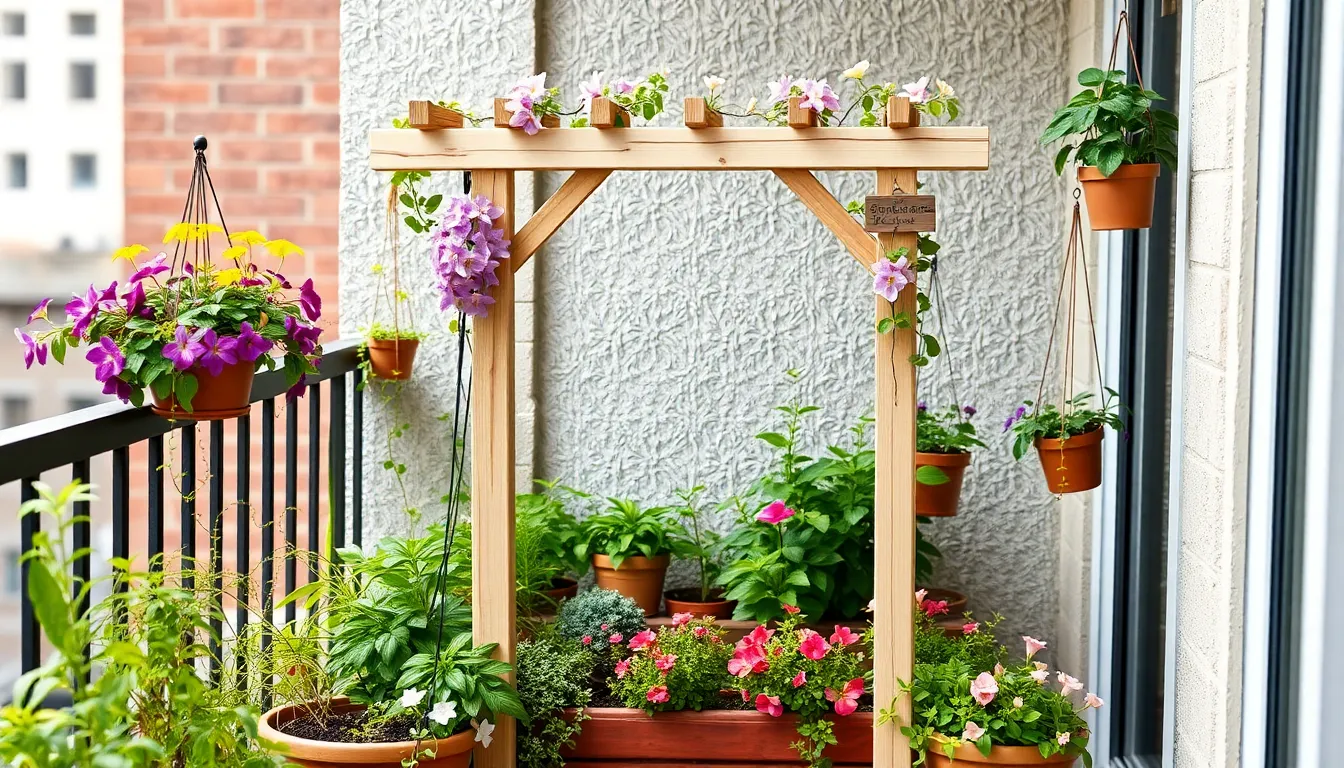
Small gardens deserve charming architectural elements just like their larger counterparts. We’ve discovered that miniature arbors can transform even the tiniest outdoor spaces into enchanting garden sanctuaries.
Compact Trellis Designs
Vertical gardening transforms limited space into lush green walls using compact trellis structures. We recommend selecting narrow trellis designs that support climbing plants like ivy or clematis without overwhelming small garden areas. These space saving structures maximize growing potential in balconies and petite garden corners.
Climbing plants create natural beauty when paired with the right trellis framework. We’ve found that clematis varieties offer stunning seasonal blooms while maintaining manageable growth patterns for compact spaces. Ivy provides year round coverage that softens angular trellis lines and adds texture to vertical surfaces.
Small trellises work exceptionally well in container gardens where traditional arbors won’t fit. We suggest choosing lightweight materials that won’t strain container bases while still providing adequate plant support. These miniature structures create focal points in pot arrangements and define different garden sections.
Apartment Balcony Answers
Portable arbors offer flexibility for renters who can’t install permanent structures. We’ve discovered that lightweight aluminum and cedar designs provide durability while remaining easy to relocate when needed. These moveable answers adapt to changing balcony layouts and seasonal plant arrangements.
Hanging planters enhance arbor functionality by adding vertical growing space around the structure. We recommend incorporating trailing plants that cascade from hanging containers to create layered visual interest. This combination maximizes both horizontal and vertical growing potential in confined balcony spaces.
Balcony weight restrictions require careful consideration when selecting arbor materials and plant combinations. We suggest consulting building management about weight limits before installing larger structures. Lightweight alternatives like bamboo or hollow metal frames provide structural support without exceeding balcony capacity.
Fairy Garden Scale Arbors
Fairy garden arbors create enchanting settings in the smallest possible spaces using miniature proportions. We’ve found that these tiny structures work perfectly in container gardens and tabletop displays where traditional arbors would overwhelm the scale. Handmade pieces from sources like Etsy offer unique designs specifically crafted for miniature garden applications.
Whimsical details transform simple arbor structures into magical focal points for fairy themed gardens. We recommend adding tiny furniture pieces and themed decorations that complement the arbor’s scale and design. These miniature accessories create storytelling opportunities within small garden spaces.
Flowered arches and simple structural designs work best for fairy garden applications. We suggest selecting arbors with delicate proportions that won’t dominate miniature plant arrangements. These scaled down versions maintain all the charm of full sized arbors while fitting perfectly into container and indoor garden settings.
Entrance and Pathway Arbor Installations
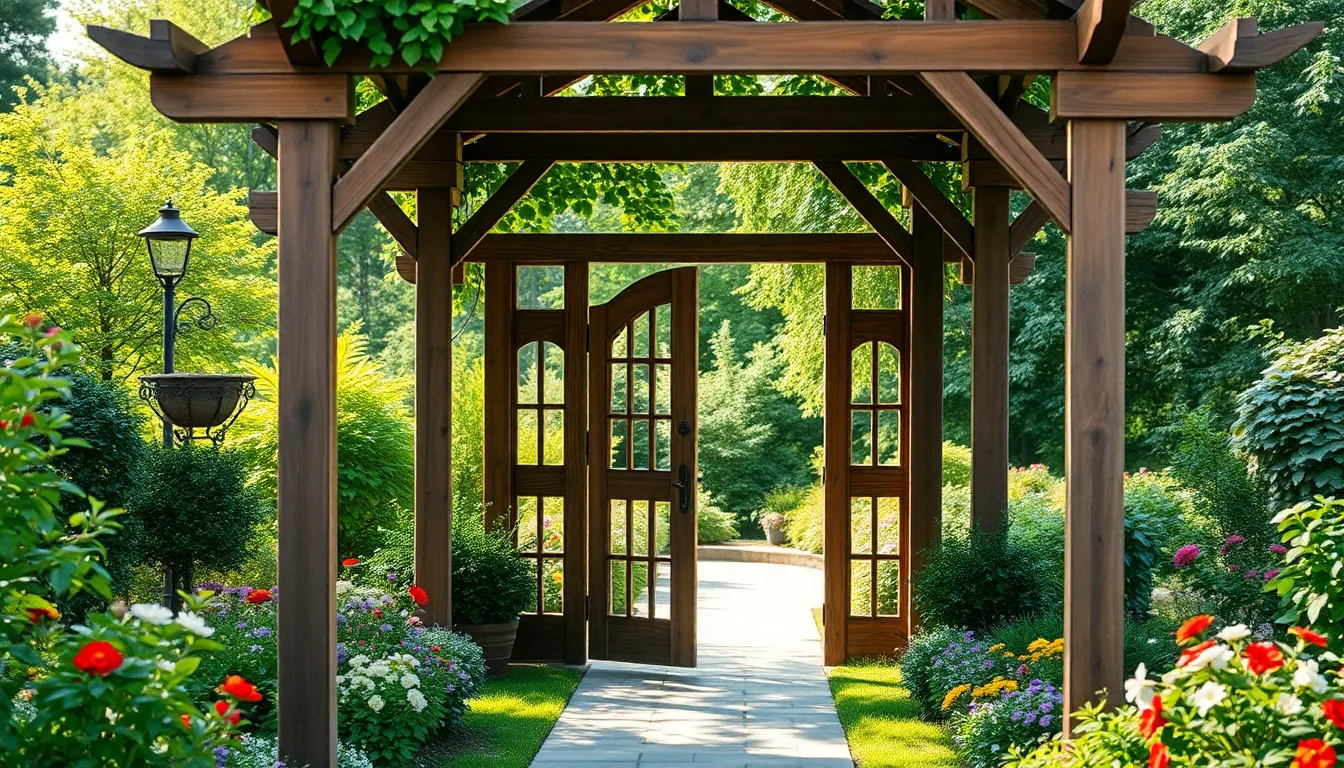
Transform your garden’s entrance and pathways with strategically placed arbors that create stunning visual transitions while serving practical purposes.
Garden Gate Integration
Garden gate arbors combine functionality with aesthetic appeal by creating seamless entry points into your outdoor space. Integrated gate designs eliminate the need for separate structures by incorporating the entrance directly into the arbor framework. This approach ensures architectural continuity while maximizing the visual impact of your garden entrance.
Gated arbors enhance privacy and create a sense of enclosure while serving as welcoming entry points for visitors. We recommend choosing ornate details or rustic elements that complement your existing garden style and arbor design. Professional installation ensures proper alignment and smooth operation of integrated gate mechanisms.
Consider the width requirements when planning your gate integration project. Standard garden gates measure 36 to 48 inches wide, while arbor spans typically range from 6 to 10 feet to accommodate the supporting structure and decorative elements.
Walkway Framing Concepts
Walkway framing transforms ordinary garden paths into captivating journeys through your industry. Arched arbors made from metal or wood provide natural shade while defining your garden’s layout and circulation patterns. These structures guide visitors along predetermined routes while creating photo worthy moments throughout the space.
Trellis arbors with integrated benches offer dual functionality by framing pathways and providing comfortable seating areas for rest and contemplation. We’ve found that positioning these combination structures at pathway intersections creates natural gathering spots that encourage longer garden visits.
Multiple arbor installations work exceptionally well for longer pathways. Spacing arbors 15 to 20 feet apart creates rhythm and visual continuity while preventing the path from feeling overwhelming or cluttered.
Property Boundary Markers
Property boundary arbors serve as attractive alternatives to traditional fencing while clearly defining space divisions. Decorative arbors mark territorial limits without creating harsh visual barriers that might detract from your garden’s overall aesthetic appeal. These installations work particularly well along front yard perimeters where you want to maintain neighborhood friendliness.
Japanese style arbors offer minimalist boundary marking answers that blend seamlessly with contemporary industry designs. Bamboo and cedar construction materials provide authentic aesthetics while requiring minimal maintenance compared to other natural options. These understated structures create subtle territorial definitions without overwhelming smaller garden spaces.
Strategic placement along property lines allows boundary arbors to support climbing plants that create natural privacy screens over time. We recommend positioning these structures 8 to 12 feet apart to ensure adequate plant coverage while maintaining structural integrity.
Seasonal Decorating Ideas for Garden Arbors
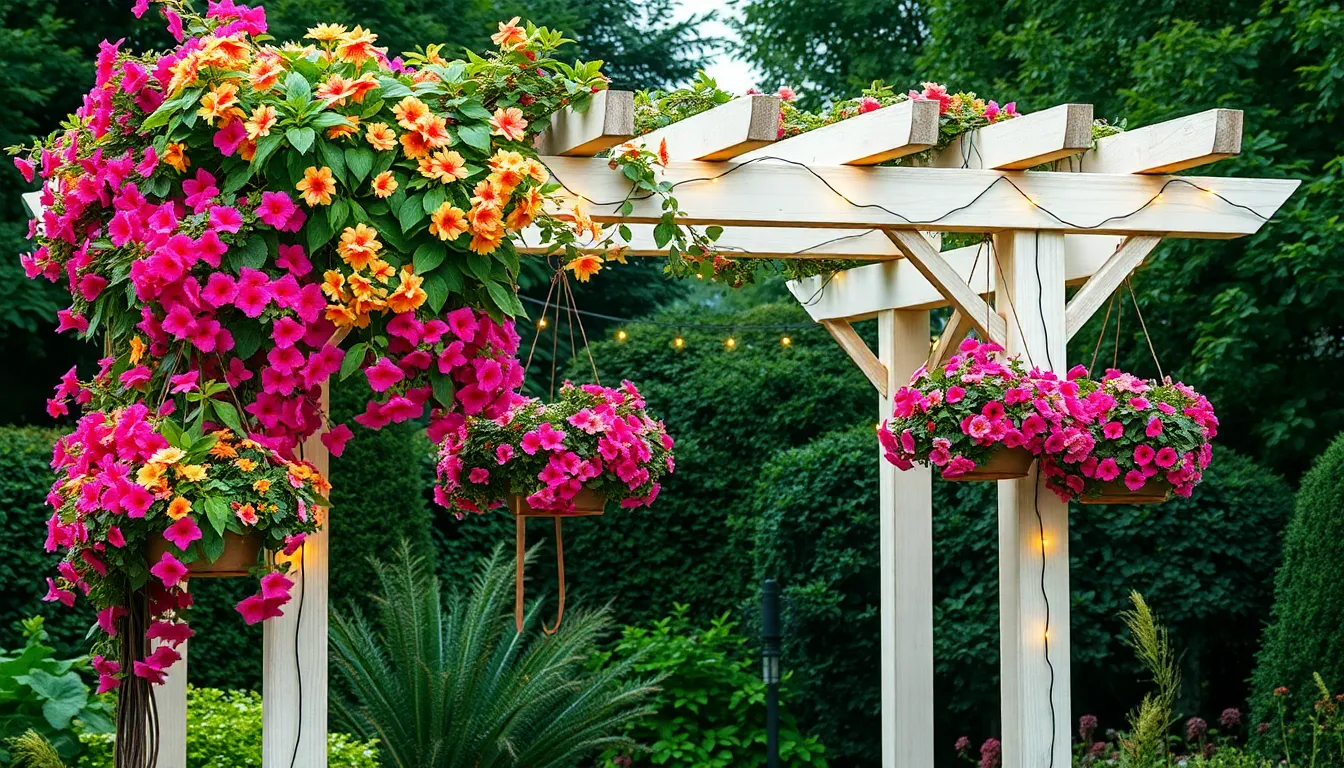
Transform your garden arbor into a year-round focal point with strategic seasonal decorations that complement nature’s changing palette. We’ll explore creative ways to enhance your arbor’s appeal through every season.
Spring and Summer Enhancements
Flowering vines bring natural beauty to arbors during warm months, with roses and clematis creating stunning blooms that cascade gracefully over the structure. Growing seasons offer the perfect opportunity to establish vigorous climbing plants that’ll provide lasting coverage.
Lanterns and fairy lights illuminate evening garden spaces, creating magical ambiance for outdoor entertaining and relaxation. Colorful paper lanterns add whimsical charm during spring celebrations, while delicate string lights provide subtle elegance throughout summer evenings.
Fresh greenery wrapping transforms bare arbor frames into lush garden features that blend seamlessly with surrounding plantings. Garlands of eucalyptus, ivy, or seasonal foliage create instant fullness while climbing plants mature.
Hanging planters maximize vertical growing space, allowing cascading flowers and trailing herbs to spill beautifully from elevated positions. Lightweight containers filled with petunias, trailing verbena, or cherry tomatoes add color without overwhelming the structure.
Fall and Winter Styling
Autumn leaf arrangements celebrate seasonal transitions with rich oranges, deep reds, and golden yellows that complement dying garden colors. Artificial fall foliage provides lasting beauty when natural leaves fade, maintaining visual interest through winter months.
Warm lighting displays become essential as daylight hours shorten, with battery-powered LED strings offering reliable illumination without electrical complications. Solar-powered options provide eco-friendly lighting answers that automatically activate at dusk.
Evergreen branch wrapping creates festive winter coverage using pine, fir, or cedar branches that maintain their color through cold months. Natural materials blend perfectly with garden settings while providing texture and subtle fragrance.
Winter berry accents add pops of color against neutral winter backgrounds, with holly berries, winterberry, or artificial alternatives creating striking focal points. These elements bridge the gap between autumn’s last colors and spring’s first blooms.
Holiday Decoration Themes
Halloween transformations turn arbors into spooky gateways using artificial spider webs, battery-operated jack-o’-lanterns, and orange lighting that creates dramatic shadows. Black fabric draping adds mysterious atmosphere without permanent modifications.
Christmas styling incorporates traditional garlands, festive ribbons, and twinkling fairy lights that transform arbors into holiday entrance features. Weatherproof ornaments and LED lighting ensure decorations survive winter weather conditions.
Easter celebrations welcome spring with pastel-colored artificial eggs, fresh flower arrangements, and soft ribbon accents that signal renewal and growth. Light, cheerful decorations complement emerging garden life while maintaining sophisticated appeal.
Seasonal theme flexibility allows the same arbor structure to accommodate various celebrations throughout the year, maximizing investment value while providing creative opportunities. Removable decoration systems make transitions between seasons effortless and enjoyable.
Maintenance and Care Tips for Long-Lasting Garden Arbors
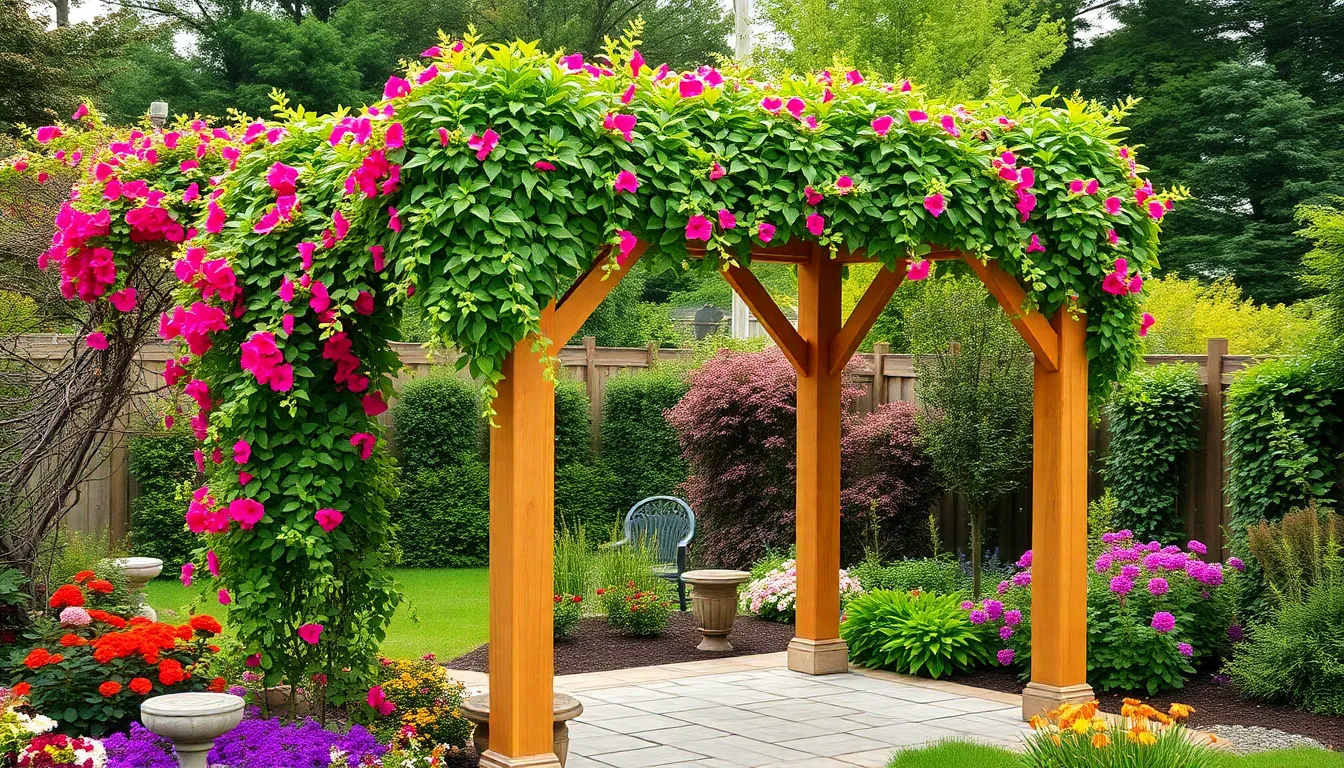
Proper maintenance ensures your garden arbor remains a beautiful focal point for years to come. We’ll cover essential care strategies that protect your investment and keep your arbor looking its best.
Weather Protection Strategies
Protective coatings serve as the first line of defense against harsh weather conditions. Metal arbors require periodic painting to prevent rust formation, while wooden structures need regular staining or sealing to maintain their integrity. Vinyl and metal materials offer lower maintenance alternatives for homeowners seeking weather resistant options.
Material selection significantly impacts long term durability and maintenance requirements. Cedar naturally resists moisture and insects, reducing the need for frequent treatments. Powder coated steel provides excellent corrosion resistance in coastal environments. Regular inspection of bolts, screws, and joints several times per year ensures structural stability during severe weather events.
Strategic placement considerations help minimize weather exposure to your arbor structure. Installing arbors in partially sheltered locations reduces direct exposure to driving rain and harsh winds. Proper drainage around the base prevents water accumulation that can weaken foundations over time.
Cleaning and Restoration Methods
Regular cleaning prevents dirt buildup and maintains visual appeal throughout the growing season. We recommend using mild soap answers and soft brushes to remove accumulated debris without damaging protective finishes. Power washing works effectively for metal arbors but requires careful pressure control on wooden structures.
Restoration techniques address wear and damage before they compromise structural integrity. Sanding and refinishing wooden arbors every 2-3 years extends their lifespan significantly. Touch up painting on metal components prevents rust spots from spreading to larger areas.
Seasonal maintenance schedules optimize arbor condition year round. Spring cleaning removes winter debris and allows for thorough inspections. Fall preparations include applying protective treatments before harsh weather arrives. Winter checks ensure snow loads don’t exceed structural limits.
Plant Management and Pruning
Plant selection directly affects arbor longevity and maintenance needs based on growth patterns and mature weight. Lightweight climbers like clematis place minimal stress on structures compared to heavy vines such as wisteria. Choosing appropriate plants prevents structural damage from excessive weight loads.
Regular pruning maintains both plant health and arbor integrity throughout the growing season. We recommend trimming climbing plants monthly during active growth periods to prevent overgrowth. Removing dead or diseased growth protects both the plant and underlying structure from damage.
Weight management prevents structural strain as plants mature and produce fruit or flowers. Monitoring vine growth helps identify when additional support becomes necessary. Installing supplementary wires or cables distributes plant weight more evenly across the arbor frame.
Conclusion
Garden arbors offer endless possibilities to transform any outdoor space into something truly special. We’ve shown you that whether you’re working with a sprawling backyard or a tiny balcony these versatile structures can enhance your garden’s beauty and functionality.
The key is choosing the right style materials and features that match your exact needs and aesthetic preferences. From classic wooden designs to modern metal frames and creative DIY projects there’s an arbor solution for every budget and skill level.
Remember that proper plant selection seasonal decorating and regular maintenance will keep your arbor looking stunning year after year. With these ideas and tips you’re ready to create a beautiful focal point that’ll serve as the perfect gateway to your garden paradise.
Frequently Asked Questions
What is a garden arbor and why should I add one to my outdoor space?
A garden arbor is a decorative archway structure that serves both aesthetic and functional purposes in outdoor spaces. It creates beautiful entrances, natural divisions between garden areas, and provides support for climbing plants. Arbors enhance visual appeal, add architectural interest, and can solve common gardening challenges while serving as stunning focal points that transform ordinary pathways into captivating garden features.
What are the most popular materials for building garden arbors?
The most popular materials include wood (cedar, pine, pressure-treated lumber), metal (wrought iron, steel, copper, bronze), and repurposed materials like old doors or pallets. Cedar is favored for its weather resistance and low maintenance, while metal options offer durability and architectural elegance. Each material provides different aesthetic appeals and maintenance requirements to suit various garden styles and budgets.
Can I build a garden arbor myself, and how much does it cost?
Yes, DIY garden arbors are achievable for budget-conscious gardeners. Simple wooden frame constructions using affordable materials like cedar or pine can significantly reduce costs. Repurposed materials like old doors and pallets offer unique character while keeping expenses low. Step-by-step tutorials from sources like Instructables and Woodshop Diaries provide guidance for accessible DIY construction projects.
What climbing plants work best with garden arbors?
Popular climbing plants include flowering vines like clematis and scarlet runner beans for vibrant blooms throughout the season. Evergreen options like English ivy provide year-round coverage. Consider seasonal color coordination by choosing plant combinations that ensure continuous blooms from spring through winter, creating stunning displays while maintaining visual interest in all seasons.
How do I maintain my garden arbor to ensure it lasts?
Regular maintenance includes applying protective coatings, selecting durable materials, and following seasonal cleaning schedules. Weather protection strategies and proper restoration methods help maintain visual appeal. Plant management is crucial—monitor climbing plant growth and prune regularly to prevent structural strain. Proper upkeep protects your investment and ensures long-lasting beauty and functionality.
Are there arbor options for small spaces and container gardens?
Yes, miniature arbors work perfectly for small spaces. Compact trellis designs support climbing plants without overwhelming tiny gardens, while portable arbors suit apartment balconies. Lightweight materials accommodate weight restrictions. Fairy garden scale arbors create enchanting settings in container gardens and tabletop displays, maintaining full-sized arbor charm while fitting seamlessly into limited spaces.
How can I decorate my garden arbor for different seasons?
Transform arbors into year-round focal points with seasonal decorating. Spring and summer enhancements include flowering vines, lanterns, and hanging planters. Fall and winter decorations feature autumn leaves, warm lighting, evergreen branches, and winter berries. Holiday themes for Halloween, Christmas, and Easter add festive appeal using flexible, removable decoration systems for easy transitions.
What functional features can I add to my garden arbor?
Consider built-in seating to create relaxing retreats, corner bench configurations for larger arbors, and hidden storage compartments for gardening tools. Lighting elements include solar-powered systems and integrated electrical options for enhanced ambiance and safety. These functional additions maximize utility while maintaining aesthetic appeal, making your arbor both beautiful and practical for everyday use.

